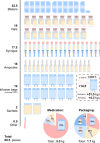Circular material flow of medication in the intensive care unit
- PMID: 40394680
- PMCID: PMC12093750
- DOI: 10.1186/s13054-025-05434-3
Circular material flow of medication in the intensive care unit
Abstract
Background: Intensive care units (ICUs) contribute significantly to healthcare's environmental footprint, with medications playing a major role. This study performed a comprehensive Material Flow Analysis (MFA) of medications in a large academic ICU to quantify material flows and identify opportunities for sustainability.
Methods: A single-center MFA was conducted at a 50-bed ICU, analyzing all medications delivered in 2023. Medication and packaging components were weighed and categorized by active pharmaceutical ingredients (APIs), excipients, and packaging type. Total annual mass as well as daily medication and packaging waste per patient were calculated.
Results: The annual medication inflow totaled 234,337 kg, including 194,411 kg of medication content (5287 kg APIs, 189,124 kg excipients) and 39,923 kg of packaging. APIs constituted only 2.3% of the total medication mass. On average, patients received 89.5 medication units daily, totaling 5.0 kg of medication and generating 1.7 kg of packaging waste. Waste outflow comprised 194,413 kg to the sewage system, 21,894 kg for incineration, and 18,030 kg recycled, consisting primarily of continuous renal replacement therapy (CRRT) bags.
Conclusions: This MFA highlights significant opportunities to enhance ICU medication sustainability by targeting CRRT-related waste, optimizing fluid formulations to reduce excipient use, and minimizing packaging. These findings support the development of targeted interventions to reduce the environmental footprint of critical care.
Keywords: Circular economy; Environmental sustainability; Healthcare waste; Intensive care unit; Material flow analysis; Medication.
© 2025. The Author(s).
Conflict of interest statement
Declarations. Ethics approval and consent to participate: Not applicable. Consent for publication: Not applicable. Competing interests: The authors declare no competing interests.
Figures



Similar articles
-
Circular material flow in the intensive care unit-environmental effects and identification of hotspots.Intensive Care Med. 2023 Jan;49(1):65-74. doi: 10.1007/s00134-022-06940-6. Epub 2022 Dec 8. Intensive Care Med. 2023. PMID: 36480046 Free PMC article.
-
Discarded intravenous medication in the ICU: the GAME-OVER multicenter prospective observational study.Crit Care. 2025 Feb 21;29(1):84. doi: 10.1186/s13054-025-05299-6. Crit Care. 2025. PMID: 39985053 Free PMC article.
-
Evaluating the carbon footprint of sedation practices in intensive care.Nurs Crit Care. 2025 Jan;30(1):19-26. doi: 10.1111/nicc.13092. Epub 2024 Jun 12. Nurs Crit Care. 2025. PMID: 38866584
-
Interventions to reduce low-value care in intensive care settings: a scoping review of impacts on health, resource use, costs, and the environment.Intensive Care Med. 2024 Dec;50(12):2019-2030. doi: 10.1007/s00134-024-07670-7. Epub 2024 Oct 25. Intensive Care Med. 2024. PMID: 39453490 Free PMC article.
-
The carbon footprint of critical care: a systematic review.Intensive Care Med. 2024 May;50(5):731-745. doi: 10.1007/s00134-023-07307-1. Epub 2024 Feb 28. Intensive Care Med. 2024. PMID: 38416200
References
-
- Bein T. The CO(2) footprint of intensive care medicine-let’s go green. Med Klin Intensivmed Notfmed. 2023;118(5):358–61. 10.1007/s00063-023-01012-z. - PubMed
-
- Gaetani M, Uleryk E, Halgren C, Maratta C. The carbon footprint of critical care: a systematic review. Intensive Care Med. 2024;50(5):731–45. 10.1007/s00134-023-07307-1. - PubMed
MeSH terms
Grants and funding
LinkOut - more resources
Full Text Sources

